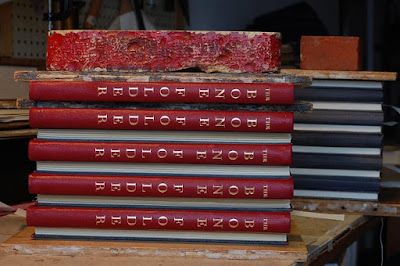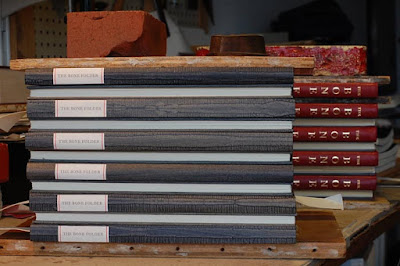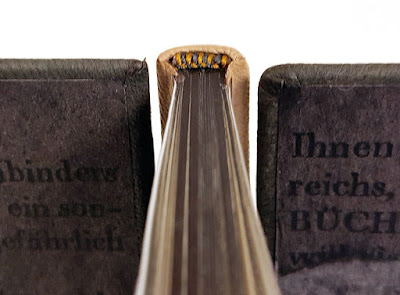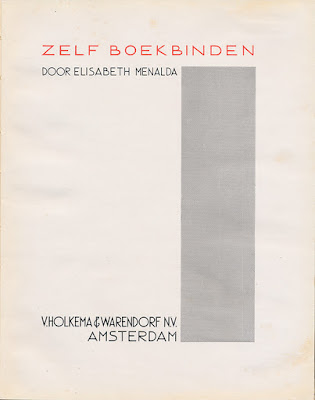Unter den Beilage war dieses schöne Zeichen für die Werkstatt von Friedrich Meink aus Berlin. Leider konnte ich bis jetzt keinen abgebildeten Einband von Meink finden, aber wie viele seiner Kollegen schrieb auch er Aufsätze in Fachzeitschriften und Ausstellungskataloge. Ein Beispiel der letzteren Kategorie war der Meinks Aufsatz "Die Zunftsprache des Buchbinders," daß in dem Katalog Ausstellung Handwerklicher Einbandkunst im Museum des Güstrower Kunst- und Altertumsvereins - 21. September bis 15. Oktober 1924 erschien. Meink war auch mit einem Einband an Collins Pressbengel in der Ausstellung vertreten. Ernst Collin schrieb auch einen Aufsatz in dem Katalog.
Unten zwei Abbildungen aus der Heftlade – Meinks Zeichen und ein Inserat für seine Werkstatt. Der Holzschnitt ist von Friedrich Schult aus Güstrow.
Just acquired another bound volume of Die Heftlade, a "modest" journal published by Ernst Collin for the Jakob-Krause-Bund 1922-24. Very glad I acquired this as it mentioned that the two issues of Vol 2, 1924 were bound in, as well as being described as missing only one of the inserts. My original copy of this journal only included vol 1, had water damage, and was missing most inserts... Still, considering that it had been published in an edition of 400 copies a rare find - essential for the Ernst Collin collector/bibliographer.
One of the inserts was this beautiful logo for the bookbinder Friedrich Meink from Berlin. While have not been able to find a binding image, like many of his peers, Friedrich Meink also wrote articles and essays that appeared in journals and exhibit catalogs. An example of the latter was the essay, "Die Zunftsprache des Buchbinders" ("The Trade Language of Bookbinders") that appeared in the catalog Ausstellung Handwerklicher Einbandkunst im Museum des Güstrower Kunst- und Altertumsvereins - 21. September bis 15. Oktober 1924 that Ernst Collin also wrote an essay for. The catalog indicated that Meink exhibited a binding on Collin's Pressbengel.
Below two items from Die Heftlade – the first Meink's logo, the other an advertisement for his bindery in Berlin. The woodcut is by Friedrich Schult in Güstrow.
 |
| Meinks Zeichen | Logo for Friedrich Meink, Berlin Holzschnitt von | Woodcut by Friedrich Schult |
Meink advertised his workshop for hand bookbinding as producing simple and fine bindings in leather, parchment, linen, and paper with hand-tooling, leather and inlays and mosaic, and Batik. Also portfolios, mats, and the restoration of old bindings.
 |
| Inserat für die Werkstatt von | Advertisement for the workshop of Friedrich Meink |
An der selben Addresse war der Lette Verein, eine Berufsbildungsstätte wo Paul Kersten und Maria Lühr die Buchbinderei unterrichteten. Der Lette Verein wurde 1866 gegründet.
At the same address is the Lette Verein, a technical school originally just for women where Paul Kersten and Maria Lühr taught bookbinding. The Lette Verein was founded in 1866.





























